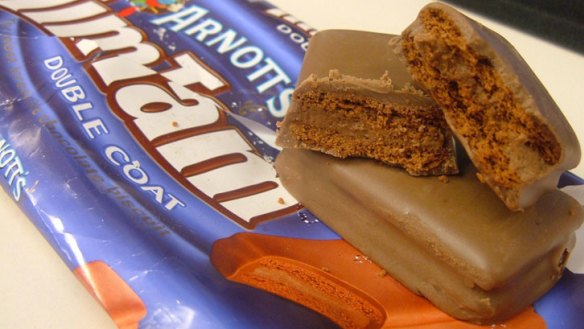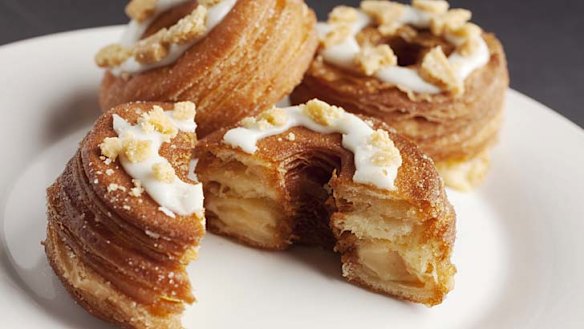Why 'super-treats' are such a health issue

The cronut, that croissant-doughnut hybrid that spawned imitations around the world, has been designated by Time magazine as one of 2013’s 25 best inventions.
But not everyone agrees.
Sydney nutritionist Catherine Saxelby, who runs the Foodwatch healthy eating website, calls the cronut ‘‘absolutely deadly’’. Although she can see why it has created such a buzz, resulting in daily queues outside the New York bakery of its founder Dominique Ansel. It sells each cronut for $US5 ($5.49) - but the black-market value has reportedly been up to 20 times that amount. Ansel is trademarking the cronut name, but versions under other monikers have sprung up elsewhere - including Australia, where Sydney master chef Adriano Zumbo has developed the Zonut. Movida Bakery in Melbourne also launched a version, the dossant.

So much ingenuity. So many kilojoules.
There is, it seems, something in human nature that cannot see one calorie without wanting to combine it with another. Vanilla ice-cream was once a treat. Now there’s cookies-and-cream and a million other calorific versions.
The 1990s saw the arrival of the stuffed crust pizza, with extra cheese rammed into the rim. Recently we’ve witnessed the arrival of the hot-dog stuffed pizza crust. And of course, the Zinger pie.
Churros, once just a long Spanish donut, can now be found - even in Melbourne - in ‘‘designer’’ varieties stuffed with custard, chocolate, caramel, strawberries or Nutella. And yes, you can still dip them in chocolate. This week in Sydney Luke Mangan tweeted a photo of the ''churro sandwich" writing: "Perfecting the Churros Sandwich: Churros, fig ice cream, caramel salted peanuts, amazing".
Saxby says the problem with this approach is that things that were once rare treats - ice-cream, pizza, plain cakes or cinnamon donuts - have become everyday, even ho-hum. Hence the phenomenon of double-treats to tantalise jaded tastebuds - and the kilojoules pile up.
‘‘We are becoming a bit numb. We want something that’s that much better,’’ she says.
A normal Tim Tam serve has 399 kilojoules, but the ‘‘double choc’’ version contains 488kJ. A ‘‘classic vanilla’’ Peters Drumstick contains 940kJ per serve, but the ‘‘super choc’’ has 1080kJ. A Magnum Classic has 1181kJ per serve; the ‘‘honeycomb crunch’’ limited edition has 1426kJ.
But clearly they sell, because there are more and more calorie-crammed foods, all trying to hit what Saxelby calls ‘‘our bliss point’’ - that perfect pitch of sugary, salty, buttery, crispy, whatever.
‘‘When we see something that hits our bliss point we can’t stop eating,’’ says Saxelby.
It’s a fatal human weakness, hardwired into us since our far-distant ancestors, for whom sweetness served as an indication that something was not just good but also safe to eat.
For cavemen, treats were rare. For us, they are cheap and ubiquitous.
‘‘Obesity is such a problem for our society because we are so overfed and we are so sedentary,’’ Saxelby says.
Unfortunately for our health, bliss-point foods still ‘‘fire off some neurone in our brains’’.
Enter marketing departments and other experts able to target human weakness from all angles - not least our hunger for a bargain.
Take potato chips: a 200gm packet costs only a little more than a 50gm one - and that appeals to the thrifty part of our brains. So do all those fast-food ‘‘meal deals’’, and cafes that offer a coffee for $3, but a coffee-and-muffin deal for a few cents more. Then there are those mega-serve fast-food special editions with names such as Quad Stack or Super Whopper.
Such things ‘‘license people to buy something they wouldn’t normally buy’’, Saxelby says.
‘‘It all preys on our inability to say no.’’
The world of burgers is full of exampled of calorie-cramming. KFC’s Double Down burger came with bacon and melted cheese sandwiched between two deep-fried chicken fillets that acted as the ‘‘bun’’. Burger King in the US has reportedly started offering a French Fry Burger - a beef patty topped with chips.
But back to the cronut. The queues in New York remind Saxelby of the way people once craved Krispy Kreme donuts because they were new and available from one or two outlets.
Right now the cronut has a similarly mythic (if more upmarket) status.
‘‘It’s new, trendy, hard to get,’’ says Saxelby. ‘‘It’s very sinful and bad for you, but it tastes divine.’’
Saxelby acknowledges people are weary of being told to eat less fat and sugar, or just eat less generally.
The trick with super-treats, she says, is to enjoy them ‘‘mindfully’’.
She endorses the advice in Mireille Guiliano’s book French Women Don’t Get Fat: ‘‘She said three teaspoons of any dessert is all you need.’’
If you try a cronut, Saxelby advises, cut it in half, or share it with a friend. Savour each mouthful, and ‘‘be aware that these things are calorific bombs.’’
Whatever you do, don’t succumb to what she calls ‘‘the Tim Tam effect’’. That’s when you find yourself alone with a packet of chocolate biscuits and vow to have ‘‘just one’’ - only to find, half an hour later, that half a dozen have vanished.
So how do mere mortals, with our susceptible brains and expanding waistlines, avoid this perfect storm of deliciousness, marketing and ingenious calorie cramming?
‘‘Keep your treats small and keep them simple,’’ Saxelby says.
AAP
The best recipes from Australia's leading chefs straight to your inbox.
Sign up- More:
- Health and nutrition